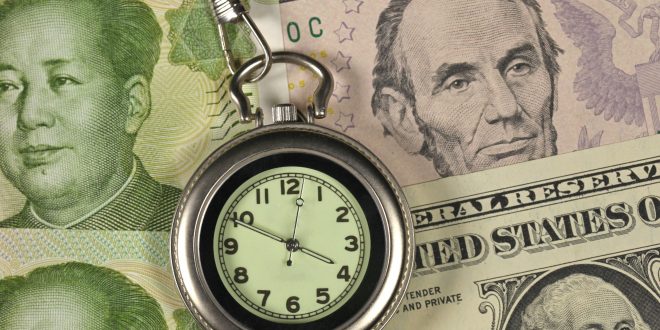In his prepared remarks for delivery at the Jackson Hole Economic Symposium titled “Macroeconomic Policy in an Uneven Economy,” FOMC Chairman Jerome Powell said that there has been clear progress towards full employment and that he believes that if the US economy develops as expected, “it may be appropriate to start tapering this year.”
But Powell said at the Federal Reserve’s annual Jackson Hole conference that the timing and pace of the tapering should not be seen as an indication of when interest rates would start to rise, a message the market viewed as pessimistic because it would keep credit cheap.
“My view is that the ‘substantial further progress’ test has been met for inflation.”
“Incoming data should provide more evidence supply–demand imbalances are improving, more evidence of continued moderation in inflation.”
“Rising durables prices a principal factor lifting inflation above 2% goal.”
“Since July, there has been more progress on employment but also the further spread of the Delta variant.”
“Will be carefully assessing incoming data and the evolving risks.”
“Timing and pace of taper will not be intended to carry a direct signal regarding the timing of interest rate liftoff.”
“We have much ground to cover to reach maximum employment.”
“Time will tell whether we have reached 2% inflation on a sustainable basis.”
“Despite today’s challenges, US economy is on path to labor market like before pandemic.”
“With substantial slack remaining in labor market and pandemic continuing, such a mistake could be particularly harmful.”
“Baseline outlook is for continued progress toward maximum employment, inflation returning to 2%.”
“Labor conditions improving but turbulent.”
“Outlook for labor market has brightened considerably in recent months.”
“Favorable conditions for job seekers should help economy cover ‘considerable remaining ground’ to reach maximum employment.”
“Prospects are good for continued progress toward maximum employment.”
“Changes we made last year to statement on longer-run goals and monetary policy strategy are well suited to address today’s challenges.”
“There has been clear progress toward maximum employment.”
“Also expect to see continued strong job creation.”
“If sustained higher inflation were to become a serious concern, fed would certainly respond, use tools to assure inflation runs consistent with our goal.”
“Responding to temporary fluctuations in inflation may do more harm than good.”
“Inflation at these levels is a cause for concern.”
“Elevated inflation readings likely to prove temporary.”
“Even after asset purchases end, our elevated holdings of longer-term securities will continue to support accommodative financial conditions.”
“Seems unlikely durables inflation will continue to contribute importantly over time to overall inflation.”
Wall Street
Wall Street rebounded Friday, August 27, with the S&P500 and Nasdaq hitting their closing highs for the fourth time during the week, as US Federal Reserve Chairman Jerome Powell’s remarks at the Jackson Symposium calmed concerns about the schedule for tapering have investors heading into the weekend with buying sentiment. The three indices recorded weekly gains.
The Dow Jones Industrial Average rose 241.63 points, or 0.69%, to 35,454.75 points, the S & P500 index closed up 39.33 points, or 0.88%, to 4509.33 points, and the Nasdaq Composite Index increased 180.08 points, or 1.2%, to 15,125.89 points.
Europe
European shares rose on Friday, August 27, after Federal Reserve Chairman Jerome Powell showed no signs that the Fed would cut its massive stimulus program. The pan-European Stoxx 600 index closed up 0.4%, with mining shares up 1.9%, while real estate stocks rose 1.5%.
Friday’s gains helped the Stoxx 600 ended the week with a 0.8% gain after holding steady for several days. Commodity-related stocks were the best performers of the week, recovering from their sharp losses.
Oil
Oil prices rose 2% on Friday, August 27, posting the biggest weekly gain in more than a year, as energy companies began halting US production in the Gulf of Mexico before a major hurricane is expected to hit early next week.
Brent crude futures rose $1.63, or 2.3 percent, to settle at $72.70 a barrel, while US West Texas Intermediate crude rose $1.32, or 2%, to a settlement price of $68.74. This is the highest close for Brent since August 2 and for WTI since August 12.
On a weekly basis, Brent is up more than 11%, and West Texas Intermediate is up more than 10%, the most significant weekly percentage gains for both since June 2020.
US oil rigs rose five to 410 this week; Baker Hughes Energy Services said, the highest level since April 2020.
In August, energy companies added 25 oil rigs, the largest number in a month since January, raising the number of rigs 12 months in a row for the first time since July 2017.
US Dollar
The dollar fell Friday, August 27, after the market deemed Federal Reserve Chairman Jerome Powell’s easing speech, even as he indicated that the Fed’s massive support for the economy might begin to taper off by the end of the year.
The dollar index, which measures the performance of the US currency against a basket of six major currencies, fell 0.42% to 92.6540.
The euro rose 0.39% to $1.1797, while the yen rose 0.23% to $109.8200.
The yields of the benchmark 10-year Treasury bonds fell 2.5 basis points to 1.3188%, after jumping to 1.375 percent, the highest level since August 12.
The New Zealand dollar fell slightly after Prime Minister Jacinda Ardern announced that the closure due to Corona in Auckland would likely remain in place for another two weeks.
 Noor Trends News, Technical Analysis, Educational Tools and Recommendations
Noor Trends News, Technical Analysis, Educational Tools and Recommendations





